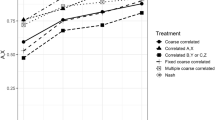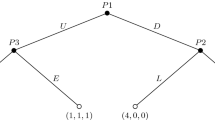Abstract
The strategy method is an experimental procedure for eliciting a complete strategy of play for all information sets, not only the ones that happen to be reached during the course of a play of a game. We use it to elicit individual strategy profiles for a class of large group, market entry games in which the payoff for a player who enters on a given market capacity value decreases linearly in the difference between the capacity value and the corresponding number of entrants. Our results show that the aggregate frequencies of entry do not differ from previous results obtained under the more common decision method. Under both methods, the number of entrants across a large set of market capacity values is organized remarkably well by the equilibrium solution. In contrast, theindividual profiles do not support mixed equilibrium play; only three of the sixty profiles suggest attempts at randomization or “mixing” between periods. About half of the individual profiles appear to converge, albeit slowly, to cutoff decision policies and more than a quarter of the profiles exhibit a variety of patterns that defy classification.
Similar content being viewed by others
References
Axelrod, R. (1984). The Evolution of Cooperation. New York: Basic Books.
Daniel, T.E., Seale, D.A., and Rapoport, A. (1998). “Strategic Play and Adaptive Learning in the Sealed-Bid Bargaining Mechanism.” Journal of Mathematical Psychology. 42, 133–166.
Fader, P.S. and Hauser, R. (1988). “Implicit Coalitions in a Generalized Prisoner's Dilemma.” Journal of Conflict Resolution. 32, 553–582.
Gilbert, R. and Lieberman, M. (1987). “Investment and Coordination in Oligopolistic Industries.” Rand Journal of Economics. 18, 17–39.
Levin, D. and Smith, J.L. (1996). Entry Coordination in Auctions: An Experimental Investigation. Ohio State University, Unpublished manuscript.
Linhart, P.B., Radner, R., and Satterthwaite. M.A. (1989). “Introduction: Symposium on Noncooperative Bargaining.” Journal of Economic Theory. 48, 1–17.
Linhart, P.B., Radner, R., and Schotter, A. (1990). “Behavior and Efficiency in the Sealed-Bid Mechanism.” C.V. Starr Center for Applied Economics, Report No. 90–51.
Milchtaich, I. (1996). “Congestion Games with Player-Specific Payoff Functions.” Games and Economic Behavior. 13, 111–124.
Milchtaich, I. (1998). “Crowding Games are Sequentially Solvable.” International Journal of Game Theory. 27, 501–509.
Mitzkewitz, M. and Nagel, R. (1993). “Experimental Results on Ultimatum Games with Incomplete Information.” International Journal of Game Theory. 22, 171–198.
Radner, R. and Schotter, A. (1989). “The Sealed-Bid Mechanism: An Experimental Study.” Journal of Economic Theory. 48, 179–220.
Rapoport, A., Daniel, T.E., and Seale, D.A. (1998). “Reinforcement-Based Adaptive Learning in Asymmetric Two-Person Bargaining with Incomplete Information.” Experimental Economics. 1, 221–253.
Rapoport, A. and Fuller, M. (1995). “Bidding Strategies in a Bilateral Monopoly with Two-Sided Incomplete Information.” Journal of Mathematical Psychology. 39, 179–196.
Rapoport, A., Seale, D.A., Erev, I., and Sundali, J.A. (1998). “Equilibrium Play in Large Group Market Entry Games.” Management Science, 44, 129–141.
Rapoport, A., Seale, D.A., and Winter, E. (1997). “Coordination and Learning Behavior in Large Groups with Asymmetric Players.”Working Paper 97.098, Department of Marketing, Hong Kong University of Science and Technology.
Rosenthal, R.W. (1973). “A Class of Games Possessing Pure-Strategy Nash Equilibria.” International Journal of Game Theory. 2, 65–67.
Roth, A.E. (1995). “Bargaining Experiments.” In J.H. Kagel and A.E. Roth (eds.), Handbook of Experimental Economics. Princeton: Princeton University Press, pp. 253–348.
Selten, R. (1967). “Die strategiemethode zur erforschung des eingeschränkt rationalen verhaltens im rahmen eines oligopolexpriments.” In H. Sauermann (ed.), Contributions to Experimental Economics, Vol. 1. Tübingen: J.C.B. Mohr, pp. 136–168.
Selten, R. and Buchta, J. (1999). “Experimental Sealed Bid First Price Auctions with Directly Observed Bid Functions.” In D.V. Budescu, I. Erev, and R. Zwick (eds.), Human Behavior and Games: Essays in Honor of Amnon Rapoport. Mahwah, NJ: Erlbaum, pp. 79–102.
Selten, R. and Güth, W. (1982). “Equilibrium Point Selection in a class of market entry games.” In M. Diestler, E. Fürst, and G. Schwadiauer (eds.), Games, Economic Dynamics, and Times Series Analysis. Wien-Würzburg: Physica-Verlag, pp. 101–116.
Selten, R, Mitzkewitz, M., and Uhlich, G.R. (1997). “Duopoly Strategies Programmed by Experienced Players.” Econometrica. 65, 517–555.
Sundali, J.A., Rapoport, A., and Seale, D.A. (1995). Coordination in Market Entry Games with Symmetric Players. Organizational Behavior and Human Decision Processes. 64, 203–218.
Author information
Authors and Affiliations
Rights and permissions
About this article
Cite this article
Seale, D.A., Rapoport, A. Elicitation of Strategy Profiles in Large Group Coordination Games. Experimental Economics 3, 153–179 (2000). https://doi.org/10.1023/A:1026541403088
Published:
Issue Date:
DOI: https://doi.org/10.1023/A:1026541403088




